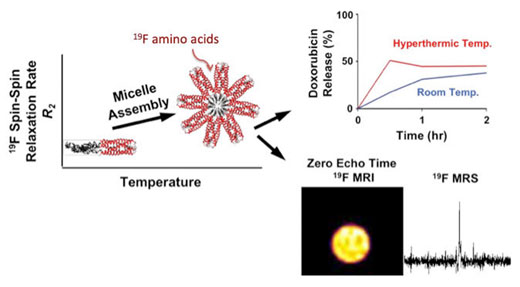| Mar 20, 2019 | |
Visualizing better cancer treatment with nanoscale protein micelles(Nanowerk News) A team of researchers from New York University has engineered nanoscale protein micelles capable of both delivering chemotherapeutic drugs and of being tracked by magnetic resonance imaging (MRI). |
|
| The innovation falls into the category of "theranostics," meaning that it combines diagnostic capability and drug delivery, allowing researchers to administer therapy while also non-invasively monitoring the therapeutic progress and drastically reducing the need for surgical intervention. | |
| The team is led by NYU Tandon School of Engineering Professor of Chemical and Biomolecular Engineering Jin Kim Montclare, who says: "Think of the analogy of a missile aimed at a target, with the chemotherapeutic drug as the missile and the cancer cells as the target. It's not enough to aim blindly; you need to carefully track the missile's progress and determine to what extent it is effective." | |
 |
|
| Schematic representation of F-TRAP assembly, thermoresponsive drug release, and detection by 19F MRS and by zero-echo time (ZTE) 19F MRI when sufficient fluorine is present. The new micelles engineered by NYU researchers answered the difficult problem of becoming visible in MRI - and can deliver drugs, as well. With such precision tracking and therapeutics delivery, perhaps surgery can be avoided. (Image: NYU) | |
| Her research paper, "Protein Engineered Nanoscale Micelles for Dynamic Magnetic Resonance and Therapeutic Drug Delivery," was published in the American Chemical Society journal ACS Nano ("Protein-Engineered Nanoscale Micelles for Dynamic 19F Magnetic Resonance and Therapeutic Drug Delivery"). It was co-authored by Radiology Associate Professor Youssef Wadhghiri at the Center for Advanced Imaging Innovation and Research and the Center for Biomedical Imaging, both at the NYU School of Medicine; Lindsay Hill, a student working with both professors; Priya Katyal, a postdoctoral researcher in Montclare's lab; Minh Hoang and Zakia Youss, both researchers working with Wadhghiri; Joseph Frezzo, Cynthia Xu, and Xuan Xie, all former students of Montclare; and Erika Delgado-Fukushima, an undergraduate student in her lab. | |
| The paper explains that engineered proteins provide an interesting template for designing fluorine-19 (19F) MRI contrast agents, yet progress has been hindered by the unpredictable relaxation properties of fluorine. (MRI relies upon detecting differences in the relaxation rates of the protons of water molecules within tissue, but there are times when the rates do not differ sufficiently between tissue types to produce useful contrast.) | |
| As a solution, Montclare and her co-authors present the biosynthesis of a protein block copolymer containing amino acid building blocks with (19F, termed "fluorinated thermoresponsive assembled protein" (F-TRAP), which assembles into a nanoscale micelle with noteworthy imaging properties along with the ability to encapsulate and release small therapeutic molecules. | |
| Previously, Montclare had developed a protein-lipid system capable of carrying not only small-molecule therapeutic drugs but nucleic acids for gene therapy at the same time, as a dual payload, in order to treat cancer, diabetes, and other conditions requiring a variety of therapeutic approaches. |
| Source: NYU Tandon School of Engineering | |
|
Subscribe to a free copy of one of our daily Nanowerk Newsletter Email Digests with a compilation of all of the day's news. |
